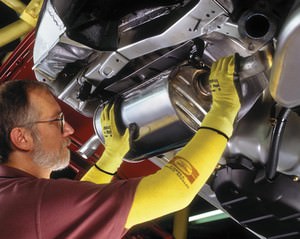
When you think safety, does bare minimum come to mind?
Choosing the right PPE for your company and workers may sound cut and dry. Take a quick look at compliance standards, choose what suits your needs and make your purchase. Right?
Wrong.
When people talk about safety standards, most think that the standards themselves are enough to protect workers from daily risks. It may be surprising to know that compliance may often involve just the bare minimum protection required to accommodate any given task. Bare minimum isn't safety. Depending on the task, there's specific equipment meant to protect workers to the fullest possible extent. Gloves are not different.
Safety gloves are one of the most important pieces of PPE to consider as they’re used in a variety of situations. Cut gloves are specifically made to protect hands and fingers from cuts and lacerations.
As a matter of fact, 30% of workplace injuries involve cuts or lacerations and a whopping 70% of them involve hands or fingers! The main cause of these accidents: workers were not wearing the proper safety gloves.
Providing the right kind of cut- resistant glove for workers takes more than simply meeting bare minimum requirements. If you are committed to higher standards of safety for your workers and higher quality protective equipment, we’ve got you covered.
When choosing a cut glove, consider:
- What is being held or worked on?
- How long is the item being held?
- How much does the item weigh?
- What is the pressure and sharpness of the item?
Considering these questions will give a better idea of which safety glove is right for the task.
There have been many recent advances in cut gloves that were previously measured by ASTM 1790 or by the manufacturer by way of measure EN388. Unfortunately, these measures gave workers a false sense of safety. The new standard ASTM F2992/F2992M-15 measures more levels of cut resistance and offers a stricter standard about what equipment is necessary to provide the highest level of safety. (Check out PIP's handy chart for more details.)
Go above and beyond the minimum standards with these great cut gloves:
- Barracuda™ Cut-Resistant Gloves are made from HPPE for a 10x stronger shell than steel and 40% more durable than other blended fabrics. Features a liquid- and abrasion-resistant polyurethane dip over a seamless knit shell. ANSI cut level 2.
- Samurai® HDPE Gloves are a high visibility and ultra-light 18-gauge cut-resistant glove with a Tuffalene® brand HDPE shell. New Foam Technology nitrile-dipped palm. Ideal for working with wet and oily applications where high grip characteristics are required. ANSI cut level A2.
- G-Tek® KEV™ Knit Kevlar® Gloves feature a Kevlar fiber shell, nitrile "MicroSurface" coated palm and fingertips with a knit wrist. Will not melt, ignite or conduct electricity. ANSI cut level A2.
Comfort Matters
As important as safety is, comfort is also another major consideration. Workers are more likely to actually wear the right protective equipment when it is also comfortable for them to wear.
Knowing what hazards exist in the workplace and what level of cut resistance is necessary to protect workers will help you properly select the correct safety gloves for that task. It is best to be proactive about the complex safety challenges your workforce faces in order to reduce injury rates, reduce accident reports and provide an overall safer work environment. By assessing which safety concerns exist and providing the correct PPE for that task, you can rest assured that your workers’ safety is in the right hands!
To learn more about the full range of PPE necessary to keep elevator workers safe, check out The Illustrated Elevator Safety Guide.
Safety: It's Your Life, It's Our Business.








